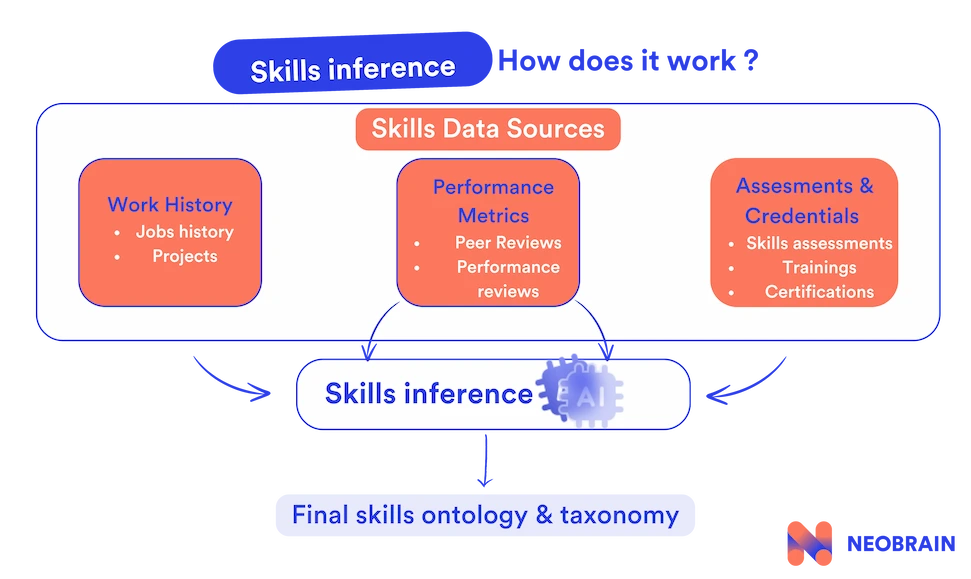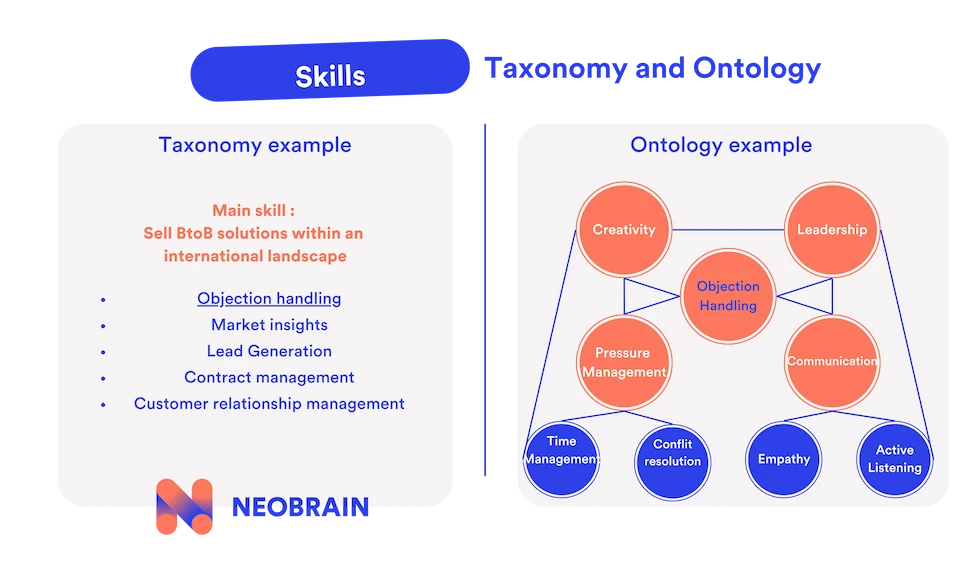Today, companies are faced with managing thousands of different skills and their countless variations. How can you identify the ones that are really important in your HR context, and how can you anticipate the ones of tomorrow to prepare your talent?
As technology redefines professional roles and expectations, the need for a structured system to meet these challenges becomes urgent. Organizations are looking for dynamic skills frameworks and mapping, but many remain stuck with outdated methods. This is where the skills ontology comes in, a real asset for developing knowledge and management of skills.
In this article, we explore the essential components, challenges and practical tips to help you create a solid skills strategy using skills ontologies.
Understanding skills ontologies
Knowing which skills are crucial to your company’s success is a major asset. Our partner, Lighthouse Research and Advisory, has emphasized the importance of management’s clarity in driving this dimension. Lighthouse found three characteristics common to companies that excel in career management:
- 89% have structured skills ontologies or frameworks (compared with only 62% of those who don’t).
- They are three times more likely to have a dedicated team or individual.
- They are 50% more likely to have formal governance for monitoring and reporting on skills.
Advantages and challenges of relying on an ontology for skills management
1. What are the advantages of adopting an ontology?
The advantages of an ontology lie in saving time in the creation of your skills architecture, and in its reliability. In the day-to-day work of HR teams and managers, here's what it can do for you:
Improved management of skills :
By clearly identifying and categorizing skills, organizations can better manage the employability of their teams, close gaps skills and make data-driven decisions. This deeper understanding supports evidence-based policy development and strategic planning.
Improved employee development and training :
Relationship mapping helps identify career paths and training needs, fostering a culture of continuous learning. Managers can guide talent development through customized training programs, mentoring opportunities and short-term projects, aligning employee growth with corporate objectives.
Streamlined workforce planning :
skills ontologies facilitate the rapid deployment of career paths, creating clear pathways for employees. This helps to ensure that employees are well prepared for new challenges, informs targeted recruitment efforts, and accelerates recruitment time by identifying potential internal candidates for upward mobility skills and promotion.
Best experiences for employees and internal recruiters:
skills ontologies provide an overview of skills, employee preferences and expertise, enabling relevant career path recommendations. For recruiters, this information highlights critical and necessary skills , ensuring a more targeted and efficient recruitment process.

2. The challenge of customizing your ontology of skills
Creating a skills framework isn't as difficult as it used to be. What really makes the difference is customizing skills data to fit your company's unique context and strategy. That's where skills ontologies come in.
For example, many vendors offer ontologies from skills containing 50,000 or 100,000 skills, which sounds like a great asset, but the key question is how well do they align with your own context and strategy?
A skills ontology is like a detailed map of the different skills and their interactions. It helps companies to precisely identify the skills required for specific roles, and to pinpoint gaps that need to be filled.
The role of a software development company goes beyond simply creating or optimizing systems.
They also identify the most relevant sets of skills and help key decision-makers choose which ones to focus on strategically.
The components of skills ontologies
A skills ontology framework is built on several key components that work together to create a comprehensive mapping of skills within an organization. These components include skills identification, categorization, relationship mapping and update mechanisms.
Identification of skills
- Definition: The process of recognizing and defining the specific skills required for various roles within the organization.
- Approach: This may involve job analyses and input from business experts. The aim is to capture a wide range of skills and formalize them in a homogeneous way. At this stage, the skills inference process comes into its own, and we’ll be taking a closer look at this tool later in the article.
- Tools: Surveys, interviews and skills frameworks are commonly used to gather this information.
Categorization of skills
- Definition: organize identified skills into logical groups or categories.
- Approach: skills can be categorized according to various criteria, such as skills technical, behavioral, cognitive, cross-functional, depending on the company’s culture and strategic objectives.
- Tools: Taxonomies and classification systems help to structure skills into manageable groups, facilitating analysis and management.
Relationship mapping
- Definition: Establishing connections between different skills to understand how they relate and interact with each other.
- Approach: This involves mapping how certain skills complement or depend on each other. For example, “Project Management” may be linked to “Leadership”, “Time Management” and “Budgeting”.
- Tools: Graphical databases and network analysis tools can visualize these relationships, creating a network of interconnected skills that highlights critical skills clusters.
Update mechanisms
- Definition: Processes and tools used to keep the skills ontology up to date and relevant.
- Approach: Regular updates are essential to reflect changes in job roles, industry standards and organizational strategy. This may involve periodic revisions, feedback loops and integration with performance management systems.
- Tools: Automated systems and AI can play a significant role in continuously updating the skills ontology by keeping pace with emerging skills , industry trends and advances in employee development.
What is skills inference?
Skills inference answers the question "How do you get information about skills employees when they don't enter it?". To take full advantage of skills inference, it's important to understand ethical considerations and identify reliable data sources. These steps ensure that the process is fair, transparent and beneficial for both employees and the organization.
Ethical considerations
Before using various data sources for inference skills, it is crucial to address the ethical considerations involved. Since this process involves inferring data and making interpretations, there is a risk of bias in the assessment of individuals. Here are the main ethical principles to follow:
- Transparency: Employees need to know what data is being collected and how it is being used.
- Confidentiality: Strong data security measures must protect personal information.
- Fairness: Using data to support impartial decisions and avoid discrimination.
- Purpose limitation: Use data strictly for professional development or performance improvement.
- Accuracy: Ensure data accuracy to avoid negative impacts on employees.
- Feedback mechanisms: Provide employees with the means to correct any erroneous data to maintain trust.
Data sources on skills
Data on skills can come from a variety of sources, which can be categorized as follows:
- Work history :
- Job history
- Projects
- Performance indicators :
- 360° feedback assessments
- Performance evaluations
- Evaluations and certifications :
- Levels of skills
- Training
- Certifications
You may be wondering how to reconcile speed and reliability in data collection. That's where AI comes in, speeding up the whole process with inference from skills.
The role of AI in the inference of skills
Artificial intelligence (AI) plays an important role in improving inference at skills. AI algorithms can analyze vast amounts of data from a variety of sources, identify patterns and make accurate predictions about an employee's skills .
Example: Case study in the retail industry
A retail company sought to streamline a skills framework that had been in place for six years. Using skills inference from a variety of data sources, it was able to transform its approach to skills management. Here's the impact from the initial situation to the new one:
Initial situation:
- Total number of trades: 91
- Average number of skills per trade: 12
New situation after skills inference:
- Average number of skills per trade: 14
- Average number of skills added by employees themselves: 4
- Average number of skills added by AI inference of skills : 5
- Average number of skills added by industry/company experts: 5
This transformation illustrates how AI can effectively improve the inference of skills, leading to a more comprehensive and accurate skills framework. By incorporating AI, the company has not only increased the number of skills relevant by business, but has also ensured that these skills are tailored to its specific context and strategy.
Skills ontology vs Skills taxonomy : what are the differences?
The terms ” skills ontology” and ” skills taxonomy”, both used in the context of creating skills frameworks, may seem similar, but they are in fact very different.
The main difference is that an ontology maps skills in a more detailed and formal way. Whereas a taxonomy simply lists and organizes skills in a hierarchy, an ontology shows how skills are related to each other and what properties they possess.
For example, a taxonomy lists "Objection management" and "Pressure management" under "Selling a BtoB service".
An ontology illustrates that “Managing objections” is linked to skills such as “Effective communication”, “Leadership”, “Creativity” and “Pressure management”.
This highlights the way in which these skills interact with each other, building bridges and breaking down silos.
Conclusion: tips for choosing and using an ontology for your competency management
In the process of creating a skills framework, the definition and choice of competencies ontologies are essential.
Here are some practical tips to guide you:
Choose complete models:
Look for skills ontologies that go beyond simple skill-toskill relationships. Make sure they include skill-to-role and role-to-role mappings, i.e. the richest possible connections. This will enable your organization to use ontologies to build career paths and internal mobility. This comprehensive approach helps identify opportunities for career progression and supports internal mobility.
Integrate data unique to your business:
Enhance ontology relevance by integrating company-specific data, such as job titles, descriptions, organizational structures and training materials. This additional layer of context ensures that the skills ontology is aligned with your specific needs and accurately reflects the unique aspects of your workforce.
Involve stakeholders:
As part of the project to formalize the repositories, present the skills content as quickly as possible to the key stakeholders, and invite them to evaluate themselves, add to it, or indicate those that are not appropriate. This ensures that the skills ontology is not just a static tool, but a dynamic resource that supports strategic talent management and development.
By focusing on these tips, you can implement and effectively use a skills ontology to gain a holistic understanding of your workforce, identify and analyze gaps at skills and support strategic talent development. This approach not only enhances your HR capabilities, but also ensures that your organization is well equipped to adapt to future challenges.









